Birdfinding.info ⇒ Common from January into September across much of its breeding range, especially from Puerto Rico eastward. Favors settled and coastal areas, so often found in seaside towns, including many of the cruise ship ports in the eastern Caribbean. Throughout the Lesser Antilles it is often one the first birds encountered upon arrival. Less common and more localized on Hispaniola, where the most consistent areas seem to be along the coasts, including Santo Domingo and the Punta Cana area. On Jamaica, it seems to be most numerous around Negril.
Caribbean Martin
Progne dominicensis
Family: Hirundinidae
Breeds in the West Indies from Jamaica and Hispaniola to Barbados and Tobago, arriving in January and departing in September.
Nonbreeding range is not well known, but appears to include parts of northern and eastern South America. Flocks have been observed overwintering on Barbados and in northern Surinam. In 2012 and 2013, a female captured on Dominica and outfitted with a data-logging geolocator spent two winters in western Bahia, Brazil, migrating through the Guianas both times, but then following different routes into the interior of the continent.
Migrants are sometimes observed on the ABC Islands and Trinidad, and in Venezuela. Some have remained for months at a time on Aruba, where colonization may be underway.
Regularly strays to Grand Cayman, sometimes in small flocks. Has also occurred as a vagrant in eastern Cuba, the southern Bahamas, Turks & Caicos, and Bermuda. There are reports from Cozumel and Belize, but these may refer to Sinaloa Martin instead.
Identification
Male is glossy indigo-black overall with a crisply defined white patch on the belly and mid-breast.
The extent of white varies widely: on many individuals it is localized to the belly and lower breast, whereas some have mostly white underparts.

Caribbean Martin, male. (Dominican Republic; June 1, 2013.) © Dax M. Román E.

Caribbean Martin, male showing white limited to belly and lower breast. (La Parguera, Puerto Rico; May 19, 2015.) © Daniele Mitchell

Caribbean Martin, male showing extensively white underparts. (El Tucuche, San Juan-Laventille, Trinidad; February 21, 2016.) © Feroze Omardeen

Caribbean Martin, male. (Añasco, Puerto Rico; June 3, 2017.) © Sadhu Govardhan

Caribbean Martin, male showing white covering entire belly and lower breast. (Dominican Republic; May 31, 2013.) © Dax M. Román E.
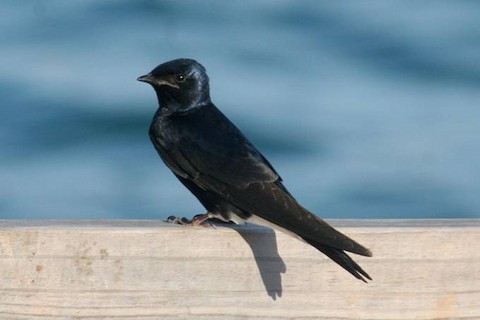
Caribbean Martin, male showing only limited white on the vent at this angle of view. (Anse Cochon, St. Lucia; June 1, 2010.) © Robert Gowan
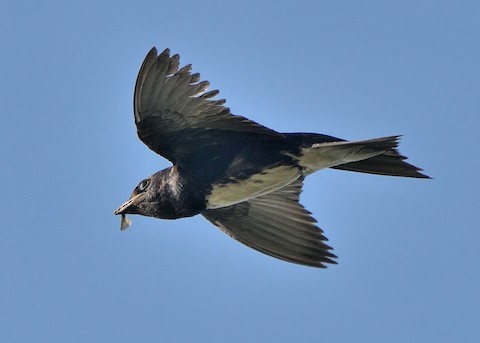
Caribbean Martin, male. (Bubali Bird Sanctuary, Aruba; August 9, 2019.) © (Michiel Oversteegen

Caribbean Martin, male and pale female. (Little Tobago Island, Tobago; May 8, 2014.) © William Stephens
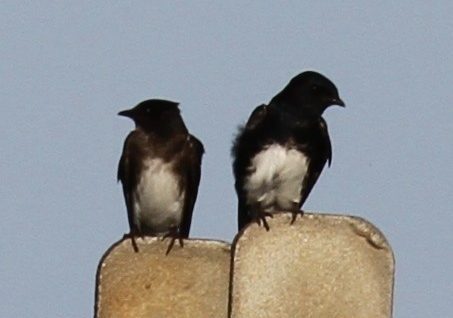
Caribbean Martin, dark female and male. (Frederiksted Pier, St. Croix, U.S. Virgin Islands.; May 2, 2014.) © Lisa Yntema
Females and immatures have dark upperparts, often extensively infused with glossy blue. Their underparts tend show some version of the male’s pattern, but ashy or brownish instead of blue-black, and the extent of white on the breast varies. However, many females are much paler and difficult to distinguish from certain other Progne martins.

Caribbean Martin, female, dorsal view showing largely blue-black upperparts. (St. Peter, Antigua; April 27, 2018.) © Bird Explorers
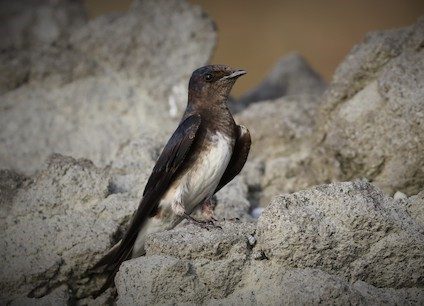
Caribbean Martin, dark female. (Morne aux Fous, Guadeloupe; June 6, 2018.) © Anthony Levesque

Caribbean Martin, pale female. (El Yunque National Forest, Puerto Rico; March 23, 2014.) © Alan Van Norman
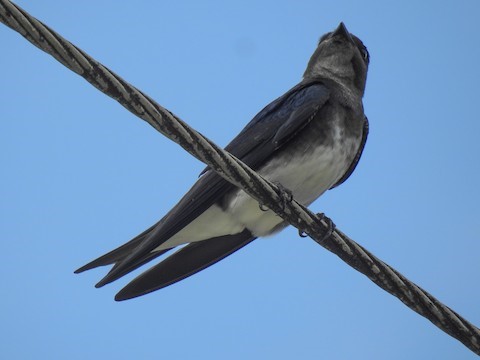
Caribbean Martin, female with ragged boundary between gray and white on underparts. (Pigeon Point Heritage Park, Tobago; March 7, 2018.) © Pam Rasmussen
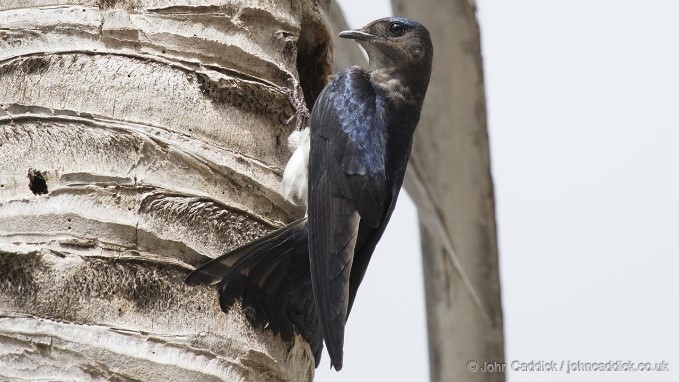
Caribbean Martin, female. (Blue Waters Inn, Tobago; May 15, 2017.) © John Caddick
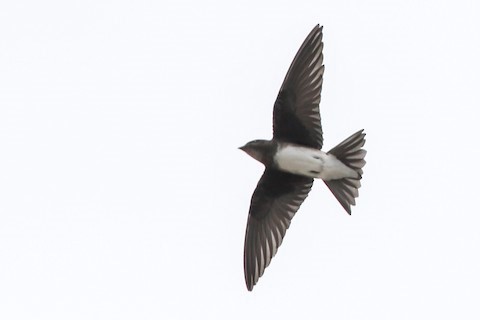
Caribbean Martin, dark female showing typical strong contrast on chest. (Old San Juan, Puerto Rico; March 15, 2018.) © Graham Williams

Caribbean Martin, pale female with tail closed. (Malmok Beach, Aruba; July 13, 2019.) © Michiel Oversteegen

Caribbean Martin, pale female or immature with tail spread. (Bubali Bird Sanctuary, Aruba; August 23, 2019.) © Michiel Oversteegen
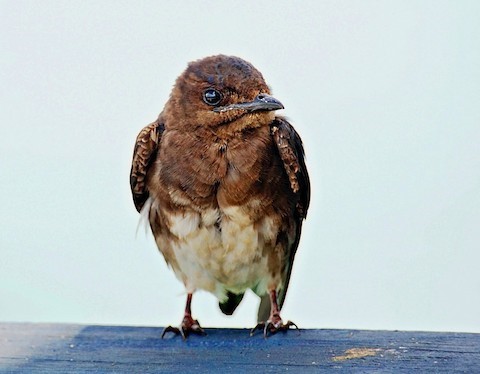
Caribbean Martin, juvenile. (Cabo Rojo National Wildlife Refuge, Puerto Rico; June 26, 2017.) © Sadhu Govardhan
Cf. Sinaloa Martin. Sinaloa and Caribbean Martins are nearly identical and were long considered a single species, the Snowy-bellied Martin, even though their breeding ranges and habitat preferences are widely separated. It is possible that they overlap on their wintering grounds, in transit, and as strays. Some authors have advised that the male Sinaloa has more extensive white on the underparts than the male Caribbean, and the female Sinaloa has a darker throat than the female Caribbean, but it seems likely that variation in both species make any such tendencies inadequate for identification.
Cf. Cuban Martin. Female Caribbean and Cuban Martins can be nearly identical, and variation in both species makes it difficult to isolate any distinctions between them. Female Caribbeans on the dark end of the spectrum tend to show the same underparts pattern as male Caribbeans: i.e., the sides are dark and the white area in the mid-breast is narrower than on female Cubans.
Cf. Gray-breasted Martin. Female Caribbean Martins at the pale end of the spectrum can be extremely similar to Gray-breasted Martin, which overlaps with Caribbean throughout its poorly understood non-breeding range. In general, the female Caribbean has a darker throat and much more pronounced contrast between the dark and light areas on the underparts, but both species vary enough that some borderline individuals are likely not distinguishable.
Notes
Monotypic species. Long considered conspecific with Sinaloa Martin (collectively the Snowy-bellied Martin, Progne dominicensis) due to their near-identical plumages, but DNA analysis has shown that they are more closely related to other species than to each other.
References
eBird. 2019. eBird: An online database of bird distribution and abundance. Cornell Lab of Ornithology, Ithaca, N.Y. http://www.ebird.org. (Accessed October 12, 2019.)
Fagan, J., and O. Komar. 2016. Peterson Field Guide to the Birds of Northern Central America. Houghton Mifflin Harcourt, New York.
ffrench, R. 2012. A Guide to the Birds of Trinidad & Tobago (Third Edition). Cornell University Press, Ithaca, N.Y.
Garrido, O.H, and A. Kirkconnell. 2000. Field Guide to the Birds of Cuba. Cornell University Press, Ithaca, N.Y.
Haynes-Sutton, A., A. Downer, R. Sutton, and Y.-J. Rey-Millet. 2009. A Photographic Guide to the Birds of Jamaica. Princeton University Press, Princeton, N.J.
Howell, S.N.G., and S. Webb. 1995. A Guide to the Birds of Mexico and Northern Central America. Oxford University Press, Oxford.
Latta, S., C. Rimmer, A. Keith, J. Wiley, H. Raffaele, K. McFarland, and E. Fernandez. 2006. Birds of the Dominican Republic and Haiti. Princeton University Press, Princeton, N.J.
Perlut, N.G., T.C. Klak, and E. Rakhimberdiev. 2017. Geolocator Data Reveal the Migration Route and Wintering Location of a Caribbean Martin (Progne dominicensis). Wilson Journal of Ornithology 129:605-610.
Raffaele, H. 1989. A Guide to the Birds of Puerto Rico and the Virgin Islands. Princeton University Press, Princeton, N.J.
Raffaele, H., J. Wiley, O. Garrido, A. Keith, and J. Raffaele. 1998. A Guide to the Birds of the West Indies. Princeton University Press, Princeton, N.J.
Ridgely, R.S., and G. Tudor. 1989. The Birds of South America, Volume I: The Oscine Passerines. University of Texas Press, Austin.
Turner, A., and G.M. Kirwan. 2018. Caribbean Martin (Progne dominicensis). In Handbook of the Birds of the World Alive (J. del Hoyo, A. Elliott, J. Sargatal, D.A. Christie and E. de Juana, eds.). Lynx Edicions, Barcelona. https://www.hbw.com/node/57711. (Accessed January 15, 2018.)
Wells, J.V., and A.C. Wells. 2017. Birds of Aruba, Bonaire, and Curaçao. Cornell University Press, Ithaca, N.Y.
Williams, N.R. 2010. Caribbean Martin (Progne dominicensis), version 1.0. In Neotropical Birds Online (T.S. Schulenberg, ed.). Cornell Lab of Ornithology, Ithaca, N.Y. https://doi.org/10.2173/nb.carmar1.01.
